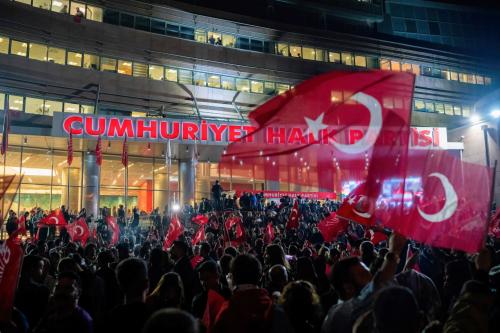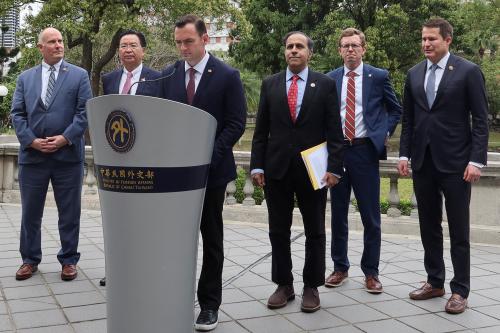Madame Park Geun-hye was elected president of the Republic of Korea on December 19, 2012, and was greeted on December 27 by a grim report on international relations in Northeast Asia for the next five years. In its 2013-2017 Mid-term Foreign Relations Analysis, prepared before the election, the Institute for Foreign Affairs and National Security (IFANS), affiliated with the Ministry of Foreign Affairs and Trade, diagnosed that “the next administration would encounter the most tortuous external environments in the 21st century,” full of challenges and uncertainties. Foremost among these are potential instability due to multiple power transitions in Northeast Asia, the increasing divergence among concerned countries on how to deal with North Korea, North Korea’s increased capacity in the development of weapons of mass destruction (WMD), and increased nationalistic tendencies in neighboring countries.
This sense of pessimism and alertness reflects the general tone of discussion in Seoul on Korea’s external environment and influences on its foreign and North Korea policies during Madame Park’s presidency in 2013-2017.
This essay will talk about three subjects: Madame Park’s blueprint for dealing with intransigent North Korea; North Korea’s intentions and strategies for the next five years; and the opportunities and challenges for Seoul and what it can achieve.
Madame Park’s Campaign Promises
As explained in her commentary “A New Kind of Korea” for Foreign Affairs magazine in September/October 2011, Madame Park’s campaign promises on North Korea policy can be summarized in two principles: “trustpolitik” and “alignment.”
Trustpolitik is composed of two points: first, North Korea must keep agreements it has made with South Korea and the international community, and, second, there must be assured consequences for actions that breach the peace. The alignment policy refers to bringing South Korea’s security into line with its cooperation with the North, and complementing inter-Korean dialogue with parallel international efforts. The alignment policy is said to entail assuming a tough line against North Korea at some times, and a flexible policy open to negotiations at other times. While Seoul and its allies should strengthen their posture against North Korea’s militarism and nuclear brinkmanship, they must also be prepared to offer Pyongyang a new beginning for prosperity through economic cooperation with the South.
It should be remembered that the central tenet of Madame Park’s alignment policy draws on lessons learned from the failures of both the Roh Moo-hyun and Lee Myung-bak administrations. In her Foreign Affairs essay, Madame Park implicitly criticizes the Roh administration’s sustained assistance to the North that did not induce it to abandon its bellicose strategy toward the South on the one hand, and distances herself implicitly from the Lee administration’s North Korea policy on the other hand, saying that more pressure on North Korea has not been able to influence its behavior in a meaningful way.
This line of learning from failures also includes a determination not to repeat the failures of the previous administrations in relations with the United States and China. The Roh administration gave the impression of anti-Americanism and of strengthening cooperation with North Korea and China at the cost of the ROK-U.S. alliance. This attitude provoked a defensive and distancing approach from both the United States and Japan. In contrast, the Lee administration has been regarded as endeavoring too much to strengthen the alliance between ROK and the United States, at the cost of South Korea’s relations with China. While anchoring confidently in its alliance with the United States, Park’s administration would strive for a more balanced approach to China.
It remains to be seen how good or bad these principles will be when applied in the real world of “the most tortuous external environments in the 21st century.” In any case, they will be well in tune with the United States and will be more in harmony with China’s North Korea policy than those of the Lee administration. Yet the gap with North Korea remains wide, as Pyongyang continues to hope for an enhanced version of “sustained assistance” with no strings attached.
North Korea’s intentions and strategies
Over the past five years, North Korea’s internal and foreign policies were focused on the year 2012, as the year for “opening the gate toward a strong and prosperous country.” Policies have been implemented through a synchronized “great surge” in internal mobilization and outward aggressiveness, especially since 2009. With the successful inauguration of the Kim Jong Un regime and increased capacities for WMD shown at the end of 2012, the North Korean leadership may feel somewhat comfortable that it has successfully rebalanced power relations in its favor―both between regime and society and between North Korea and the international community. In the beginning of 2013, North Korea might think the time has arrived to test neighboring countries and the United States, and to try to establish a new atmosphere for relations with them.
In the past five years, North Korea strove to acquire abilities and to establish the perception that it might seek to dictate terms of any new negotiation with South Korea and the United States. It strengthened its capacities for nuclear weapons and missile capabilities, and showed off its potential for aggressive behavior toward South Korea. Tactically, North Korea alternated between phases of aggressiveness and accommodation. While adapting policies to changing circumstances, North Korea has never lost its five strategic objectives for regime survival. It is important to keep in mind these five strategic objectives when we interpret North Korea’s tactical moves, especially its apparently accommodating ones:
- North Korea aspires to expand its nuclear as well as missile capabilities and to be recognized by the international community as a nuclear power, especially by South Korea and the United States.
- It aims to establish a peace regime on the Korean peninsula and normalize relations with the United States as a recognized nuclear power.
- It seeks to establish vertical relations with South Korea in which the South will provide political and economic support for the North Korean regime.
- It aspires to secure the necessary funds to maintain its regime by actively developing diverse foreign-currency earning projects (mineral exports, influx of foreign aid, etc.), while striving to contain any reform measures that could increase productivity of the domestic economy.
- It strives to maintain internal political stability through preferential treatment of groups loyal to the regime and by strengthening public security organizations.
Through his 2013 New Year’s Address, Kim Jong Un may have wanted to signal North Korea’s return to tactics of accommodation with South Korea and the United States. After the successful missile launch on December 12, 2012 and while showing off its capacities for detonating a third nuclear device, North Korea may have felt confident and decided to test the intentions of the incoming administrations in Seoul and Washington. Although he showed great pride in the successful launch of the Unha 3 rocket, in his speech Kim Jong Un avoided language which might irritate the new Park and Obama administrations. North Korea executed the same sort of about-face from aggressiveness to accommodation in July 2009, after its missile launch in April and second nuclear experiment in May.
There are some structural and circumstantial reasons for North Korea to introduce moderation into its domestic and foreign policies and to try to reset relations with neighboring countries in 2013. The heightened tension of the past five years was exhausting not only for neighboring countries, but also for North Korea. Even under this unfavorable external environment of high tension and reduced assistance, North Korea sustained the three year (2009-11/12) “great surge” of mass mobilization that featured a drastic increase in investments, though for political consolidation rather than economic rehabilitation: massive construction of monumental buildings and show-case facilities in Pyongyang; a “high technology breakthrough” for advancing capacities for WMD; an infusion of capital to resuscitate huge state firms in the heavy and chemical sectors, though without reform; and, last but not least, the enthronement of Kim Jong Un. To fund these projects, North Korean authorities not only amplified mineral exports, but also significantly increased internal exploitation through measures such as revaluing the North Korean won in November 2009 and stepping up the confiscation of food from farmers to feed Pyongyang and the military.
In the past, North Korea has introduced a phase of policy moderation, the so-called “buffer period,” after such a “great surge.” Whether the leadership subjectively liked it or not, the buffer period was required to overcome systemic exhaustion from the mobilization and confrontation that characterize such surges, and to prepare for another big push in the future. Under such a structural necessity, North Korea may have decided to try to work out a new kind of modus vivendi with the South and the United States beginning in 2013. If so, North Korea might be prepared to show some readiness for concessions, while testing the intentions of the South and the United States with regard to some level of reopening of tension reduction and economic cooperation. As in the previous cases, however, the tendencies of policy moderation do not represent a new strategy, but are meant to buy time to prepare for a new surge of aggressiveness and mobilization, sometime in the future.
Opportunities and challenges
All in all, South Korea and the United States, and North Korea, seek to test the other’s intentions and, if possible, to change the current circumstances in their mutual relations to a better footing in the beginning of 2013. South Korea and the United States want to constrain North Korea’s development of WMD and to persuade North Korea to reform and open, for its own benefit. On North Korea’s part, it may be interested in tactical accommodation, while maintaining options for confrontation. This is the best case scenario for a new modus vivendi; North Korea will reject a more binding and fundamental resolution.
Though there exists a certain, limited, possibility for mutual accommodation, it remains questionable whether the three parties could restart and maintain a tough process of dialogue and mutual pressure in “the most tortuous external environments in the 21st century” without jeopardizing the possibilities for forward progress. The challenges for the South and the United States―which include increased skepticism about Pyongyang’s trustworthiness, the reality of North Korea’s increased WMD capacities, and continued divergence between China and other parties on how to deal with North Korea―will prove to be most daunting in comparison to previous years. Considering North Korea’s unwillingness to make―and to keep―real and sincere concessions regarding its development of WMD, the room for improvement in inter-Korean relations is also limited, even though the Park Geun-hye administration will try sincerely to improve them. Without a new and internationally binding scheme for dealing with North Korea’s WMD development, progress above a certain level in inter-Korean relations would remain illusory and would most likely provoke a feeling of betrayal, in the end.
Nevertheless, president-elect Madame Park’s principles of trust and alignment will be a good starting point for a North Korea policy discussion and coordination between the South and the United States. Unfortunately, the task will be easier in the negative sense, if North Korea undertakes provocative actions even before the start of the mutual test of intentions. If North Korea’s turn to tactical moderation in domestic and foreign policy becomes more pronounced during 2013, it will provide the South and the United States with both opportunities and challenges. If North Korea continues to behave prudently even after the renewed sanctions by the UNSC for its December 12 missile launch, abstains from a third nuclear device test, and shows some signs of good will and accommodation, then the South and the United States should go willingly into dialogue with the North and try to test its intentions.


Commentary
Op-edSouth Korea’s New President Prepares to Meet a Turbulent Northeast Asia
January 7, 2013